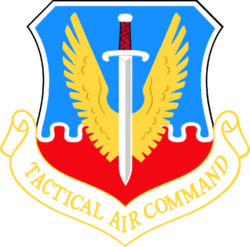67th Cyberspace Wing
67th Cyberspace Wing | |
|---|---|
|
| |
| Active | 1947–1949; 1951–1960; 1966–1993; 1993–present |
| Country |
|
| Branch |
|
| Role | Information Operations |
| Size | Wing |
| Part of | Air Force Space Command |
| Garrison/HQ | Lackland Air Force Base |
| Motto(s) | Lux ex Tenebris Latin Light from Darkness |
| Engagements | Korean War |
| Decorations |
Distinguished Unit Citation Air Force Outstanding Unit Award with V Device Air Force Outstanding Unit Award Republic of Korea Presidential Unit Citation |
| Commanders | |
| Current commander | Colonel B. Pyburn |
| Insignia | |
| 67th Cyberspace Wing emblem (approved 20 March 1952)[1] |
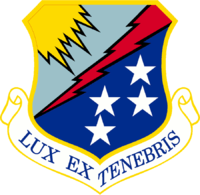 |
The 67th Cyberspace Wing is a United States Air Force wing stationed at Lackland Air Force Base, Texas. It was activated in October 1993 as a military intelligence unit and is assigned to Twenty-Fourth Air Force. The wing was first activated at March Field as the 67th Reconnaissance Wing as part of the wing base organization system. However, only its 67th Tactical Reconnaissance Group ever became operational and it relied on another wing for support. It was inactivated in the 1949 Truman reductions in the Department of Defense budget.
The wing was reactivated in Japan as the 67th Tactical Reconnaissance Wing in February 1951, replacing the 543d Tactical Support Group as the headquarters for tactical reconnaissance units during the Korean War. It moved to Korea and served in combat until the armistice was signed in July 1953. Following the war, it returned to Japan and by 1957 was the only reconnaissance unit assigned to Far East Air Forces. The wing was inactivated in 1960 and its remaining squadrons assigned to other units.
The wing was reactivated at Mountain Home Air Force Base, Idaho in 1966 and trained for reconnaissance missions. It became Tactical Air Command's replacement training unit for the McDonnell RF-4C Phantom II. From 1968 to 1970, it acquired a fighter unit and also trained fighter aircrews on the F-4. In July 1971, Mountain Home became a fighter base and the wing moved without personnel or equipment to Bergstrom Air Force Base, Texas, where it absorbed the assets of the 75th Tactical Reconnaissance Wing, which was inactivated. It continued its reconnaissance mission at Bergstrom until inactivating on 30 September 1993. The wing activated the following day at Kelly Air Force Base as the 67th Intelligence Wing and has continued the electronic intelligence mission since then.
Mission
The 67th Cyberspace Wing operates, manages, and defends global Air Force networks. The wing trains and readies airmen to execute computer network exploitation and attack. It also executes full-spectrum Air Force network operations, training, tactics, and management. It provides network operations and network warfare capabilities to Air Force, joint task force, and Unified Combatant Commands. Additionally, it performs electronic systems security assessments for the Air Force.[2]
Units
- Provides forces to conduct Air Force computer network operations for United States Strategic Command, United States Cyber Command and other combatant commands. The group conducts computer network operations and warfare planning for the Air Force, joint task forces and combatant commanders. The group also conducts Secretary of Defense-directed special network warfare missions.[2]
- Operates, manages and secures the network battlespace as part of Air Force network operations. It provides battlespace awareness, defense of the Air Force global information grid networks, network support and communications and electronic systems security assessment security of Air Force units.[2]
- Delivers and sustains continuous worldwide network operations and security for air, space and cyberspace forces.[2]
History
- For associated history, see 67th Network Warfare Group
Initial activation
The wing was first activated in November as the 67th Reconnaissance Wing at March Field, California during the experimental implementation of the wing base organization.[note 2] It was made a permanent unit and redesignated the 67th Tactical Reconnaissance Group in August 1948.[1] During this period, only the wing's 67th Tactical Reconnaissance Group was operational and the entire wing was attached to the 1st Fighter Wing.[3] The wing was equipped with various models of the Douglas B-26 Invader, North American F-6 Mustang and Lockheed F-80 Shooting Star.[1] President Truman’s reduced 1949 defense budget required reductions in the number of groups in the Air Force to 48 and the wing was inactivated in March 1949.[4]
Korean War and service in the Pacific
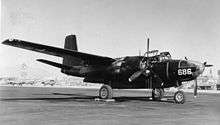
By 1951, Fifth Air Force had combined its reconnaissance units under the 543d Tactical Support Group, which was stationed in Korea. In late January, the 543d headquarters moved to Komaki Air Base Japan, and the following month it was inactivated and the 67th was activated in its place and absorbed its personnel and equipment.[1][5] The 543d's 45th Tactical Reconnaissance Squadron was transferred to the 67th, while its other squadrons were replaced by newly-activated units.[6][7]

The wing immediately began to fly combat reconnaissance missions over Korea,[3] By August, the wing had consolidated its subordinate elements at Kimpo Air Base. Gradually overcoming difficulties, it soon was providing adequate aerial intelligence for both air and ground units. However, the wing was hampered by a lack of suitable photographic equipment and aircraft and shortages of trained personnel. For a short time, the wing had to use North American T-6 Texan trainers and Douglas C-47 Skytrain cargo planes for visual resonnaissance. The wing sought to cure its problems using resources within the theater, managing its own training classes for inexperienced personnel and experimenting with aircraft, cameras and tactics. It sought to cure its lack of high speed reconnaissance aircraft by acquiring six Sabres modified for reconnaissance missions.[8]
The 67th continued flying combat missions until the armistice in late July 1953. It provided photographic coverage of enemy front lines, battlefield positions, installations, airfields and rail lines, with weather reconnaissance as a secondary task.[1]
After the war, the wing remained in the Pacific theater, moving from Korea to Itami Air Base, Japan in December 1954, continuing to provide reconnaissance as needed.[1] Wing elements were dispersed to various bases in Japan. The 45th Squadron remained in Korea until March 1955, when it moved to Misawa Air Base on Hokkaido,[9] while the 12th Squadron moved to Yokota Air Base in August 1956,[10] and the 15th Squadron was at Komaki Air Base and, later, at Kadena Air Base.[11] Only the 11th Squadron was stationed with the wing headquarters.[12]
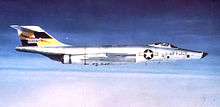
On 1 July 1957, the 67th moved to Yokota Air Base, Japan as US operations at Itami came to a close. At Yokota, it absorbed the resources of the 6007th Reconnaissance Group, which was discontinued in August, becoming the sole reconnaissance wing in the Far East.[13] In September, the wing converted to the Dual Deputate organization,[note 5] and all flying squadrons were directly assigned to the wing when its 67th Tactical Reconnaissance Group was inactivated.[14] The 67th Group had moved to Yokota in 1956 and became nonoperational upon the wing's move to Yokota and its squadrons were attached to the wing before being assigned. It also added air refueling and airlift to its mission in September, with these new tasks continuing until the wing inactivated in Dec 1960.[1]
Reconnaissance in the United States
After activation at Mountain Home Air Force Base, Idaho in 1966, the wing began training in the United States for aerial, visual, optical, electronic, thermal, and radar reconnaissance. In May, the wing added training of replacement McDonnell RF-4C Phantom II reconnaissance aircrews to its mission, and between June 1968 and November 1970, it also trained tactical fighter crews with the F-4D.[3] Preparing to turn Mountain Home Air Force Base over to the 347th Tactical Fighter Wing, the 67th served as headquarters for both organizations for its final two months at Mountain Home.[3]
The wing moved to Texas in 1971, replacing the 75th Tactical Reconnaissance Wing at and absorbing its personnel and equipment.[3] At Bergstrom, it concentrated on maintaining tactical reconnaissance mission forces capable of meeting worldwide operational requirements. It conducted reconnaissance training of Air Force, United States Marine Corps, and allied reconnaissance aircrews between 1982 and 1989.[1]
The wing acted as an advisor to Air National Guard reconnaissance units until 1992. It performed reconnaissance missions supporting the US Customs Service from 1983 until 1992. The wing hosted the Tactical Air Command sponsored worldwide tactical reconnaissance competition at its home base in 1986, 1988 and 1990.[1]
Desert Storm and inactivation
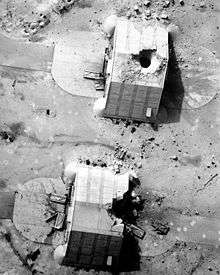
The wing deployed personnel and equipment in support of Desert Storm in 1991, photographing enemy targets, conducting searches for enemy missile sites, tracking movement of the Iraqi Republican Guard and oil slicks, and conducting overall battle damage assessment. The wing ended flying operations in August 1992, but remained active until Bergstrom Air Force Base closed the following year.[1]
Between 1993 and 2000, the wing's mission included directing planning of all-source intelligence, electronic combat, and security support for the Air Intelligence Agency. Since 2000, it has collected and analyzed intelligence and provided it to decision makers and the test and acquisition community. The wing also attacked adversary information and information systems while defending its own.[1]
Lineage
- Established as the 67th Reconnaissance Wing on 6 November 1947
- Organized on 25 November 1947
- Redesignated 67th Tactical Reconnaissance Wing on 22 August 1948[note 6]
- Inactivated on 28 March 1949
- Activated on 25 February 1951
- Discontinued and inactivated on 8 December 1960
- Activated on 2 August 1965 (not organized)
- Organized on 1 January 1966
- Redesignated 67th Reconnaissance Wing on 1 October 1991
- Inactivated on 30 September 1993
- Redesignated 67th Intelligence Wing and activated on 1 October 1993
- Redesignated 67th Information Operations Wing on 1 August 2000
- Redesignated 67th Network Warfare Wing 5 July 2006[1]
- Redesignated 67th Cyberspace Wing c. 15 September 2013[15]
Assignments
|
|
Components
- Groups
- 26th Technical Group (later 26th Intelligence Group, 26th Information Operations Group, 26th Network Operations Group, 26th Cyberspace Operations Group): 1 October 1993 – present
- 67th Reconnaissance Group (later 67th Tactical Reconnaissance Group, 67th Intelligence Group, 67th Information Operations Group): 25 November 1947 – 28 March 1949, 25 February 1951 – 1 October 1957 (attached to 6102 Air Base Wing[14] after 1 July 1957), 1 October 1993 – present[1]
- 690th Information Operations Group (later 690th Network Support Group): 5 November 2001 – present[17]
- 692d Intelligence Group (later 692d Information Operations Group, 692d Intelligence Group): 1 October 1993 – 1 October 2004[18]
- 694th Intelligence Group: 1 October 1993 – 1 January 1998[19]
- 6960th Electronic Security Group: 1 October 1993 – c. 1994
- Squadrons
- 4th Tactical Reconnaissance Squadron: 15 July – 15 October 1971
- 7th Tactical Reconnaissance Squadron: 15 December 1967 – 15 October 1971
- 9th Tactical Reconnaissance Squadron: 15 July – 31 August 1971
- 10th Tactical Reconnaissance Squadron: 1 January 1966 – 30 June 1971
- 11th Tactical Reconnaissance Squadron: attached 1 June – 24 November 1954; attached 1 July – 30 September 1957, assigned 1 October 1957 – 8 March 1960; assigned 1 April-25 October 1966
- 12th Tactical Reconnaissance Squadron: attached 1 June – 24 November 1954; attached 1 July – 30 September 1957, assigned 1 October 1957 – 8 March 1960; assigned 1 July-2 September 1966; assigned 31 August 1971 – 30 September 1992 (detached 5 May – 4 June 1974, 8 – 29 September 1977, 7 July – 7 August 1981, 15 May – 11 June 1984, 27 August – 24 September 1987)
- 15th Tactical Reconnaissance Squadron: attached 1 June – 24 November 1954; attached 1 July – 30 September 1957, assigned 1 October 1957 – 25 April 1960
- 22d Tactical Reconnaissance Squadron: 20 September 1966 – 15 October 1971 (detached 8 – 26 October 1968, 15 July – 15 October 1971)
- 45th Tactical Reconnaissance Squadron (later 45th Tactical Reconnaissance Training Squadron): attached 1 June – 24 November 1954; attached 1 July – 30 September 1957, assigned 1 October 1957 – 25 April 1960; assigned 15 October 1971 – 31 October 1975 (detached 13 June – 7 July 1973); assigned 1 April 1982 – 30 September 1989
- 62d Tactical Reconnaissance Training Squadron: 1 July 1982 – 31 December 1989
- 67th Reconnaissance Technical Squadron: 1 March 1951 – 8 December 1960, 15 July 1971 – 1 September 1977[20]
- 91st Tactical Reconnaissance Squadron: 15 July 1971 – 30 August 1991 (detached 26 April – 25 May 1972, 25 May – 9 June 1977, 1 May – 2 June 1980, 2 May – 1 June 1983, 24 April – 23 May 1985)
- 417th Tactical Fighter Squadron: 1 July 1968 – 15 November 1970 (detached 12 January – 4 April 1969 and 11 September – 10 October 1970)
- 421st Air Refueling Squadron: attached 17 – 30 September 1957, assigned 1 October 1957 – 8 December 1960 (detached 21 November – 8 December 1960)
- 548th Reconnaissance Technical Squadron: attached 1 July – 8 December 1957, assigned 8 December 1957 – 8 December 1960[21]
- 801st Reconnaissance Technical Squadron: 1 January 1966 – 15 July 1971[22]
- 4467th Tactical Reconnaissance Intelligence Support Squadron (later 4467th Reconnaissance Intelligence Support Squadron): 30 November 1990 – 30 September 1992
- 6021st Reconnaissance Squadron: attached 1 July – 8 December 1957
- 6091st Reconnaissance Squadron: attached 1 July – 30 September 1957, assigned 1 October 1957 – 8 December 1960 (detached 21 November – 8 December 1960)[16]
- Flight
- 6166th Air Weather Reconnaissance Flight, attached 25 February 1951 – 25 November 1953[8]
Stations
|
|
Aircraft
- Douglas B-26 Invader, 1947–1949; 1951–1957
- Douglas RB-26 Invader, 1947–1949; 1951–1957
- Douglas FA-26C Invader, 1947–1949
- Douglas WB-26 Invader, 1951–1957
- North American F-6 Mustang (later RF-51), 1947, 1951–1953
- Lockheed FP-80 Shooting Star (later RF-80), 1947–1949, 1951–1955
- Lockheed F-80 Shooting Star, 1952–1953
- North American RF-86 Sabre, 1951–1956
- North American F-86F Sabre, 1953
- Republic RF-84F Thunderflash, 1955–1958
- Republic F-84F Thunderstreak, 1955
- Douglas RB-66 Destroyer, 1956–1960
- Douglas WB-66 Destroyer, 1958–1960
- Douglas SC-47 Skytrain, 1957–1960
- Douglas C-54 Skymaster, 1957–1958
- Fairchild C-119 Flying Boxcar, 1957–1958
- Boeing KB-50 Superfortress, 1957–1960
- Boeing RB-50 Superfortress, 1957–1960
- Martin RB-57 Canberra, 1957–1960
- McDonnell RF-101C Voodoo, 1958–1960
- McDonnell RF-4C Phantom II, 1966–1992
- McDonnell F-4E Phantom II, 1968–1969, 1969–1970[16]
References
Notes
- ↑ The aircraft represent four different squadrons: 62nd Tactical Reconnaissance Training Squadron (yellow tail); 12th Tactical Reconnaissance Squadron (orange tail); 91st Tactical Reconniassance Squadron (red tail) and 45th Tactical Reconnaissance Training Squadron (black check tail). The lead aircraft is the wing commanders aircraft, whose fin flash represents all four squadrons. Taken 11 May 1988.
- ↑ Although the wing base organization called for a combination of the tactical group with all base units supporting it, two wings were organized at March, each with separate support units assigned. See Mueller, p. 371 (listing support units organized at March in 1947).
- ↑ Aircraft is North American RF-86A-5-NA Sabre serial 48-195.
- ↑ Aircraft is McDonnell RF-101C-60-MC Voodoo serial 56-42.
- ↑ Under this plan flying [and missile] squadrons reported to the wing Deputy Commander for Operations and maintenance squadrons reported to the wing Deputy Commander for Maintenance
- ↑ The experimental (table of distribution Reconnaissance Wing) was discontinued on 24 August 1948. The permanent (table of organization Tactical Reconnaissance Wing) had been established and activated two days earlier. The Air Force later consolidated the two wings and considers this to have been a redesignation. Ravenstein, pp. 105–107.
Citations
- 1 2 3 4 5 6 7 8 9 10 11 12 13 Robertson, Patsy (December 4, 2009). "Factsheet 67 Network Warfare Wing (AFSPC)". Air Force Historical Research Agency. Archived from the original on 13 March 2015. Retrieved June 9, 2016.
- 1 2 3 4 "Twenty-Fourth Air Force Units: 67th Cyberspace Wing". Twenty-Fourth Air Force Public Affairs. Retrieved June 9, 2016.
- 1 2 3 4 5 Ravenstein, pp. 105–107
- ↑ Knaack, p. 25
- ↑ Robertson, Patsy (April 20, 2012). "Factsheet 543 Intelligence, Surveillance and Reconnaissance Group (AFISRA)". Air Force Historical Research Agency. Retrieved November 12, 2015.
- ↑ Endicott, p. 80
- ↑ Maurer, Combat Units, p. 134
- 1 2 Endicott, p. 79
- ↑ Robertson, Patsy (May 6, 2013). "Factsheet 45 Reconnaissance Squadron (ACC)". Air Force Historical Research Agency. Retrieved June 11, 2016.
- ↑ Robertson, Patsy (March 16, 2015). "Factsheet 12 Reconnaissance Squadron (ACC)". Air Force Historical Research Agency. Retrieved June 11, 2016.
- ↑ Robertson, Patsy (July 30, 2012). "Factsheet 15 Reconnaissance Squadron (ACC)". Air Force Historical Research Agency. Retrieved June 11, 2016.
- ↑ Robertson, Patsy (March 17, 2015). "Factsheet 11 Reconnaissance Squadron (ACC)". Air Force Historical Research Agency. Retrieved June 11, 2016.
- ↑ See Fletcher, p. 196 (showing dates of 6007th Group at Yokota).
- 1 2 "Factsheet 67 Network Warfare Group (AFSPC)". Air Force Historical Research Agency. April 28, 2011. Archived from the original on 13 March 2015. Retrieved June 10, 2016.
- ↑ Hein, 2 Lt Meredith. "Two wings re-designated as "cyber"". 24th Air Force Public Affairs. Retrieved September 14, 2015.
- 1 2 3 4 Lineage, including components, assignments, stations and aircraft in Robertson, 67 Cyberspace Wing Factsheet, except as noted.
- ↑ Bailey, Carl E. (August 23, 2011). "Factsheet 690 Network Support Group (ACC)". Air Force Historical Research Agency. Retrieved June 9, 2016.
- ↑ Robertson, Patsy (April 20, 2012). "Factsheet 692 Intelligence, Surveillance and Reconnaissance Group (AFISRA)". Air Force Historical Research Agency. Retrieved June 9, 2016.
- ↑ Robertson, Patsy (April 20, 2012). "Factsheet 694 Intelligence, Surveillance and Reconnaissance Group (AFISRA)". Air Force Historical Research Agency. Retrieved June 9, 2016.
- ↑ See Mueller, p. 34 (showing dates at Bergstrom)
- ↑ Robertson, Patsy (April 20, 2012). "Factsheet 548 Intelligence, Surveillance and Reconnaissance Group (AFISRA)". Air Force Historical Research Agency. Retrieved January 20, 2016.
- ↑ See Mueller, p. 433 (showing dates at Mountain Home)
Bibliography
![]() This article incorporates public domain material from the Air Force Historical Research Agency website http://www.afhra.af.mil/.
This article incorporates public domain material from the Air Force Historical Research Agency website http://www.afhra.af.mil/.
- Endicott, Judy G., ed. (2001). The USAF in Korea, Campaigns, Units and Stations 1950–1953 (PDF). Maxwell AFB, AL: Air Force Historical Research Agency. ISBN 0-16-050901-7.
- Fletcher, Harry R (1993). Air Force Bases , Vol. II, Air Bases Outside the United States of America (PDF). Washington, DC: Center for Air Force History. ISBN 0-912799-53-6.
- Knaack, Marcelle Size (1978). Encyclopedia of US Air Force Aircraft and Missile Systems. Vol. 2, Post-World War II Bombers 1945–1973. Washington, DC: Office of Air Force History. ISBN 0-912799-59-5.
- Maurer, Maurer, ed. (1983) [1961]. Air Force Combat Units of World War II (PDF) (reprint ed.). Washington, DC: Office of Air Force History. ISBN 0-912799-02-1. LCCN 61060979.
- Mueller, Robert (1989). Air Force Bases, Vol. I, Active Air Force Bases Within the United States of America on 17 September 1982 (PDF). Washington, DC: Office of Air Force History. ISBN 0-912799-53-6.
- Ravenstein, Charles A. Air Force Combat Wings, Lineage & Honors Histories 1947–1977 (PDF). Washington, DC: Office of Air Force History. ISBN 0-912799-12-9.
- Further reading
- Futrell, Robert F. (1983). The United States Air Forces in Korea 1950–1953. Washington, DC: Office of Air Force History. ISBN 0-912799-71-4. Part 1 Part 2 Part 3 Part 4
- Rogers, Brian. (2005). United States Air Force Unit Designations Since 1978. Hinkley, UK: Midland Publications. ISBN 1-85780-197-0.
External links
- "67th Intelligence Wing". Federation of American Scientists. Retrieved June 10, 2016.
- "67 RTS History". 548th and 67th Reconnaissance Association. Retrieved June 10, 2016. (67th Reconnaissance Technical Squadron)





